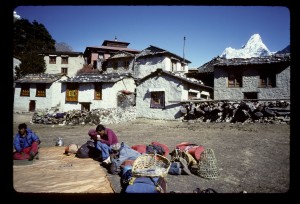Frédérick Chopin: Prélude, Opus 28, No. 15, Sostenuto, c. 1838.
Listen to the full track
Listen to the author reading the text
 [The sound of this piece reflects not so much the way it sounded as our getting used to the stone claustrophobia of the monastery with its labyrinth of conflicting echoes. We moved the microphones around subtly, listening through headphones, to achieve increasingly better sound quality. We had had no time to recover from our nausea upon arrival or to test the frozen labyrinth, with its small windows and irregular mud walls, for acoustic values.
[The sound of this piece reflects not so much the way it sounded as our getting used to the stone claustrophobia of the monastery with its labyrinth of conflicting echoes. We moved the microphones around subtly, listening through headphones, to achieve increasingly better sound quality. We had had no time to recover from our nausea upon arrival or to test the frozen labyrinth, with its small windows and irregular mud walls, for acoustic values.
So much work is involved in hooking together so many dozens of boxes with so many hundreds of feet of different cables that the pianist had run out of all patience after a few hours and just began to play, perversely circumnavigating the very goals of the new technology, so we had no choice but to punch the buttons and record what we could.
But then, he hadn’t asked. We had volunteered. We were pilgrims to the shrine—a tattered, forgotten shrine on a ravaged mountain, surrounded by nothing any of us had ever seen before, no familiar Domino’s Pizza flags, not even the small annoying symbols of safety we take for granted, like the occasional airplane. We were very alone, and it was his world, if it was anyone’s—François Seurel, technician.]
In trying to play the repeated notes in the bass which George Sand compared to raindrops, you run a risk. If you play them as softly as possible, sooner or later one will not sound, ruining the structure, the constant gentle hammering of the hammers. If, however, as happens in concert, you play it safe and play the notes louder, the rain becomes immediately obnoxious, also ruining the piece. The drizzle of repetition must become an eventual cataract in the prelude’s midsection, and then subside again into the mist.
 To me, there is great pain here, as if a child has died, or as if Chopin knew that he was sliding towards death in the cold afternoons of Paris. Although Sand claimed the piece was mimetic, imitating Majorcan rain, in fact, Chopin may have written all the preludes before he went to Majorca, according to Gutmann, Liszt, and Niecks, and tinkered with them there. Sand’s sloppy emotionalism in trying to find a simple tag for such a spider’s web of sadness caused an enormous fight, with Chopin denying that “imitative harmonies” had anything to do with it, and terming “the servile repetition of external sounds” puerile (Sand, Histoire de ma Vie). Liszt claimed the raindrop prelude was in any case the F sharp minor one, and Niecks thinks it was the B minor.
To me, there is great pain here, as if a child has died, or as if Chopin knew that he was sliding towards death in the cold afternoons of Paris. Although Sand claimed the piece was mimetic, imitating Majorcan rain, in fact, Chopin may have written all the preludes before he went to Majorca, according to Gutmann, Liszt, and Niecks, and tinkered with them there. Sand’s sloppy emotionalism in trying to find a simple tag for such a spider’s web of sadness caused an enormous fight, with Chopin denying that “imitative harmonies” had anything to do with it, and terming “the servile repetition of external sounds” puerile (Sand, Histoire de ma Vie). Liszt claimed the raindrop prelude was in any case the F sharp minor one, and Niecks thinks it was the B minor.
The bizarre notion of a composer’s using adolescent mantras to reduce elusive forms to the simple algorithms of mass acceptance, as if Beethoven had a pair of old socks in mind when he wrote the Ninth Symphony, and, yes, we can all sympathize with those socks and the universal joy at finding them together in the dryer (not an assured discovery), these romantic clichés may in fact be true, although it is the duty of poets and musicians to deny that they were inspired by an egg in a pan, and in fact, until Warhol, to distance a work of art from its often lowly origins.
Mozart, Haydn, and Bartók, the great folk composers, found their exuberant melodies in the street, and Bernstein wove his collages from already-tested motifs in Mahler. Entire measures in Lerner and Loewe musicals can be found in Brahms, or in a Copland accompaniment Loewe must have practiced over and over until it gravitated and graduated into a full-blown Broadway hit. Melodies graven into the universal race-memory have a better chance of surviving, and atonal music, in its refusal to cater to basic human desire, has no doubt dug itself an early grave, into which it tries to pull its more joyful colleagues.
Even when it is demonstrably onomatopoetic, music is still just an outline, of course, not a shopping list of socks and eggs, but a Platonic approximation of murmuring shelves whose specificities are entrusted to the shopping musician, who after all has the last word on any composition, any one note, any impulse buy.
 What interests me here is the prelude’s midsection, written in C sharp minor, that angry cognate of D flat, where the notes are exactly the same as they are in the key of D flat, except they are not flatted, but sharped. That is, instead of having a small italicized “b” in front of them, they have a “#” sign. But the notes are exactly the same.
What interests me here is the prelude’s midsection, written in C sharp minor, that angry cognate of D flat, where the notes are exactly the same as they are in the key of D flat, except they are not flatted, but sharped. That is, instead of having a small italicized “b” in front of them, they have a “#” sign. But the notes are exactly the same.
A similar visual joke is played in Chopin’s Nocturne on this disc, where the melody is just the accompaniment turned upside down.
The result, amazingly, is the philosophic opposite of D flat; although nothing has really changed, everything is different—the notes are the same, just in a different key, and so the world is thrown upside down, and familiar sounds show different colors, like the rhetorical contradictions of Romeo’s “misshapen chaos of well-seeming forms, feather of lead, bright smoke, cold fire, . . . still-waking sleep.”
One can easily find here an unconscious comparison of Majorca’s romantic damp with its deadly pulmonary equivalent, tuberculosis; or the chasm between Chopin’s domestic sensitivity and Sand’s indiscriminate cheating, the pain of a submissive nature enveloped by an oblivious predator; or the grief of Verona’s C sharp minor Montagues and Capulets destroying the bliss of their D flat major teens: same notes, different generations, two keys like two households locked to the death in harmonic cacophony.
In any case, the storm must be stressed, so the aftermath calms: this is an emotional plot, whatever its story, a statement of despair redeemed by forgiveness, rage sprung from drizzle transmuted into rainbows, Sand’s venality excused by Chopin’s grace: as with Mozart, out of incomprehensible suffering emerges a phoenix of related grandeur, correspondences that can only be recognized in retrospect.

